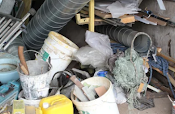
Harm Reduction - Tennessee
What is harm reduction?
Harm reduction is a set of practical, public health strategies designed to reduce potential harms associated with drug use and promote healthy lifestyles and communities. There is no universal definition for harm reduction, but the idea is to ensure there is no judgment about a person’s drug use and sexual activity, meet people where they are in terms of ability and willingness to modify behaviors and elicit positive change based on client-centered goals, needs, circumstances, and readiness to change (Syringe Services Program(SSPs), n.d.).
What are syringe services programs (SSPs)?
SSPs are programs that provide comprehensive harm reduction services. This can include, but is not limited, to sterile needle and injection drug equipment distribution; safe disposal for used needles/syringes; HIV/hepatitis C virus (HCV) testing and linkage to care; overdose prevention education and naloxone distribution; referrals to substance use disorder treatment, medical care, mental health providers, and social services; and other tools to prevent acquisition of bloodborne pathogens and sexually transmitted infections (STIs) (Syringe Services Program(SSPs), n.d.).
What are the legal authorities for SSPs in Tennessee?
Per §T.C.A. Title 68, Chapter 1 non-governmental organizations and local health departments in partnership with county government may operate a syringe services program after approval by the Tennessee Department of Health (TDH) (Syringe Services Program(SSPs), n.d.).
Does the law include zoning requirements in the legislation for SSP locations?
Yes, the law requires SSPs to be located at least 1,000 feet from any school or public park. However, there is an exception where it has to be at least 2,000 feet from a school or public park in municipalities with a population between 55,440-55,450 (Syringe Services Program(SSPs), n.d.).
What services are Tennessee SSPs required to provide?
By law, SSPs are required to provide the following services:
- Distribution of unused needles/syringes and injection drug equipment at no cost
- Collection and safe disposal of used needles/syringes and injection drug equipment
- Education on prevention of overdoses, bloodborne pathogens, and drug misuse as well as treatment for mental illness and substance use disorder
- Referral to mental health and substance use disorder treatment to individuals who request it
- Referral to or direct provision of naloxone
- Referral to or direct provision of HIV and hepatitis C testing
Who can visit an SSP?
Anyone can visit an SSP. SSPs are built on the harm reduction model, which offers support and resources to those who may need them. The following people might visit an SSP:
- Persons who use drugs (PWUD), including persons who inject drugs (PWID)
- People who are on opioid pain management treatment and would like naloxone
- People who engage in commercial sex work
- People requesting safer sex supplies and HIV and hepatitis C testing
- People who use syringes to administer prescribed medications (i.e., insulin) or non-prescribed medications (hormones and/or steroids)
- Family and friends of someone who injects drugs and would benefit from naloxone
- Persons seeking naloxone or overdose prevention education
- Persons seeking information on the prevention of bloodborne pathogens and/or sexually transmitted infections
*Operating hours for syringe service programs are subject to change. Please contact the agency listed for more information.
References
Syringe Services Program(SSPs). (n.d.). Www.tn.gov. https://www.tn.gov/health/health-program-areas/std/std/syringe-services-program.html












